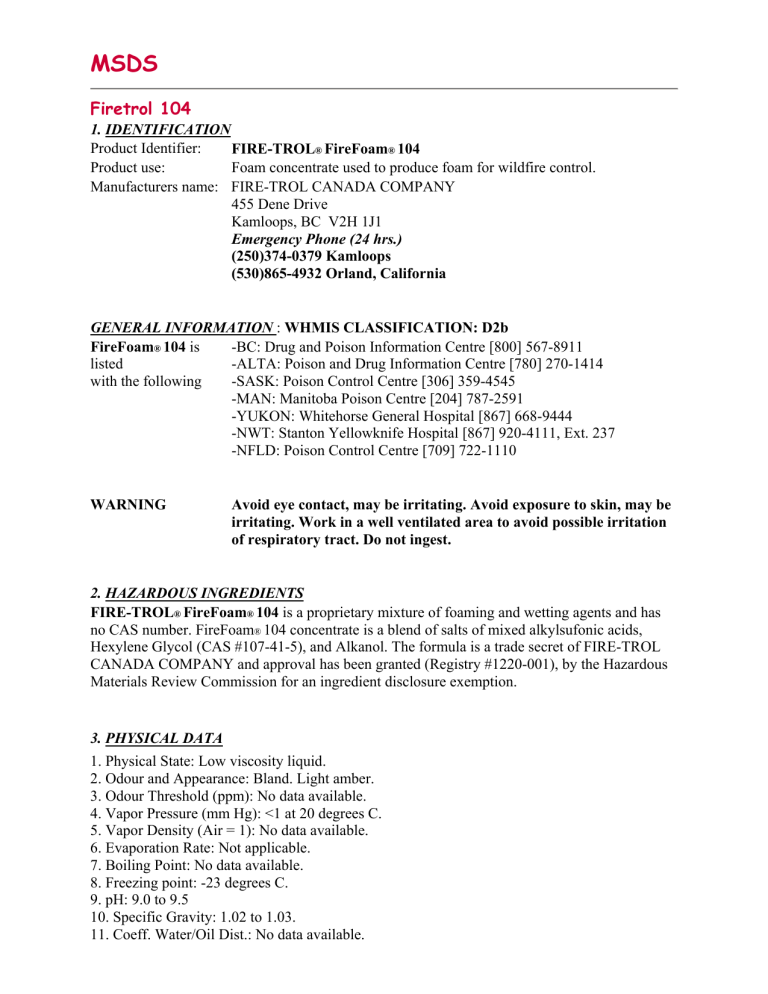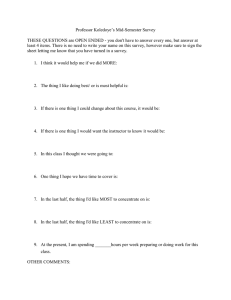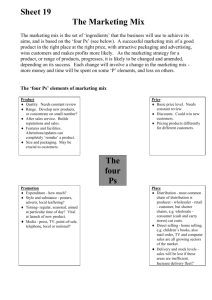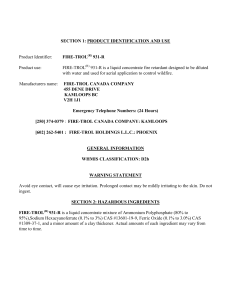Firetrol 104 - coldspringsexcelsior.org

MSDS
Firetrol 104
1. IDENTIFICATION
Product Identifier: FIRE-TROL
®
FireFoam
®
104
Product use: Foam concentrate used to produce foam for wildfire control.
Manufacturers name: FIRE-TROL CANADA COMPANY
455 Dene Drive
Kamloops, BC V2H 1J1
Emergency Phone (24 hrs.)
(250)374-0379 Kamloops
(530)865-4932 Orland, California
GENERAL INFORMATION : WHMIS CLASSIFICATION: D2b
FireFoam
®
104 is listed with the following
-BC: Drug and Poison Information Centre [800] 567-8911
-ALTA: Poison and Drug Information Centre [780] 270-1414
-SASK: Poison Control Centre [306] 359-4545
-MAN: Manitoba Poison Centre [204] 787-2591
-YUKON: Whitehorse General Hospital [867] 668-9444
-NWT: Stanton Yellowknife Hospital [867] 920-4111, Ext. 237
-NFLD: Poison Control Centre [709] 722-1110
WARNING Avoid eye contact, may be irritating. Avoid exposure to skin, may be irritating. Work in a well ventilated area to avoid possible irritation of respiratory tract. Do not ingest.
2. HAZARDOUS INGREDIENTS
FIRE-TROL
®
FireFoam
®
104 is a proprietary mixture of foaming and wetting agents and has no CAS number. FireFoam
®
104 concentrate is a blend of salts of mixed alkylsufonic acids,
Hexylene Glycol (CAS #107-41-5), and Alkanol. The formula is a trade secret of FIRE-TROL
CANADA COMPANY and approval has been granted (Registry #1220-001), by the Hazardous
Materials Review Commission for an ingredient disclosure exemption.
3. PHYSICAL DATA
1. Physical State: Low viscosity liquid.
2. Odour and Appearance: Bland. Light amber.
3. Odour Threshold (ppm): No data available.
4. Vapor Pressure (mm Hg): <1 at 20 degrees C.
5. Vapor Density (Air = 1): No data available.
6. Evaporation Rate: Not applicable.
7. Boiling Point: No data available.
8. Freezing point: -23 degrees C.
9. pH: 9.0 to 9.5
10. Specific Gravity: 1.02 to 1.03.
11. Coeff. Water/Oil Dist.: No data available.
4. FIRE AND EXPLOSION DATA
1. Flammability: Not flammable
2. Extinguishing Media: Carbon dioxide, dry chemical, foam, or water spray. Class A, BC, or
ABC fire extinguishers. Sand/earth.
3. Special Firefighting Procedures in Enclosed Areas:
In case of accident or fire involving FireFoam
®
104 Concentrate firefighters must be equipped to prevent breathing of any vapors or products of combustion. Wear an approved self-contained breathing apparatus and protective clothing. There are no special hazards involved in fighting fires involving the diluted product.
4. Flashpoint: Greater than 200 degrees F (95C). (Pensky Martens Closed Cup).
5. Upper and Lower Flammable Limits (%): Not Applicable.
6. Auto-ignition Temp.: No data available.
7. Hazardous Combustion Products: When heated to point of combustion, FireFoam
®
104
Concentrate will produce carbon dioxide (CO2), carbon monoxide (CO), and oxides of sulfur.
8. Explosion Data:
Sensitivity to Impact: Not Applicable
Sensitivity to Static Discharge: Not Applicable
5. REACTIVITY DATA
1. Stability: Excellent long-term stability. Can be used down to the freezing point of water.
Freezing point of concentrate is -10 degrees F (-23 degrees C). If frozen, concentrate can be warmed up and used with no loss of effectiveness. Do not store above 150 degrees F (66 degrees C).
2. Incompatibility: Avoid strong oxidizers such as hydrogen peroxide, bromine and chromic acid. Avoid strong reducing agents.
3. Reactivity: Not Applicable.
4. Hazardous Decomposition Products: Carbon dioxide, carbon monoxide, and oxides of sulfur.
6. TOXICOLOGICAL PROPERTIES
1. Routes of Entry:
Skin contact, inhalation of concentrate mists or vapors and ingestion can be expected to be the most common types of exposure to FireFoam
®
104 concentrate . Available information on
FireFoam
®
104 ingredients indicates that inhalation of concentrate vapors may be irritating to the upper respiratory tract. Inhalation of high concentrations of one ingredient in the FireFoam
®
104 concentrate have been shown to have adverse effects on the central nervous system. These effects include nausea, headache and dizziness. Acute ingestion of one ingredient of FireFoam
®
104 concentrate has been shown to have adverse effects on the central nervous system of laboratory animals. Chronic ingestion of alkanol II has produced adverse effects on the kidneys and livers of laboratory animals.
2. Toxicological Data:
FireFoam
®
104 - Concentrate
Oral LD50 (Rat): > 5050 mg/kg. Practically non-toxic
Dermal LD50 (Rabbit): > 2010 mg/kg. Practically non-toxic
Eye Irritation (Rabbit): Irritation score 24.8. Moderately irritating
Skin Irritation (Rabbit): Irritation score 4.0 out of 8.0. Moderate irritant.
FireFoam
®
104 - 1% Solution
Oral LD50 (Rat): > 5050 mg/kg. Practically non-toxic
Dermal LD50 (Rabbit): > 2010 mg/kg. Practically non-toxic
Eye Irritation (Rabbit): Irritation score 2.3. Practically non-irritating
Skin Irritation (Rabbit): Irritation score 0.7 out of 8.0. Slight irritant
All tests were carried out at an accredited lab under guidelines promulgated by EPA
Publication 540/9-82-025 and were in compliance with Good Laboratory Practice
Standards, Fed. Reg.48, 53946, 1983.
3. Exposure Limits:
Hexelyene Glycol 25ppm (NIOSH REL)
Alkanol I 100 ppm (OSHA PEL) 50 ppm (ACGIH TLV skin notation)
4. Effects of Acute Exposure:
Skin: Mild to Moderate Irritation.
Eyes: Mild to Moderate Irritation.
Respiratory Tract: Moderate Irritation.
5. Effects of Chronic Exposure:
No data available.
6. Carcinogenicity:
Not listed by NTP or IARC.
7. Teratogenicity:
Not listed by NTP or IARC.
8. Mutagenicity:
Not listed by NTP or IARC.
9. Reproductive toxicity:
Not listed by NTP or IARC.
10. Synergistic Products:
Not applicable.
7. PREVENTIVE MEASURES:
1. Protective clothing and equipment should be utilized when handling FireFoam
®
104 concentrate .
(i) Gloves: Avoid prolonged skin contact. Use any type of rubber, plastic, or solvent resistant gloves when handling concentrate.
(ii) Eye: Avoid eye contact. Use chemical safety goggles offering a full seal around the eyes.
(iii)Clothing: Use a neoprene type apron if working with concentrate for prolonged periods.
(iv) Footwear: Due to the wetting properties of FireFoam
®
104 rubber footwear should be worn when handling concentrate or working with the diluted product.
(v) Respirator: Avoid excessive inhalation of concentrate vapors such as may occur in a confined space. Use concentrate in a ventilated area. If a respirator is utilized, use
NIOSH/OSHA approved respirator with vapor cartridge.
2. Ventilation Type Required: Mechanical
3. Store concentrate in plastic, polyethylene, or polyethylene lined containers only. DO NOT store concentrate in metal tanks since metal contamination can affect the effectiveness of the concentrate.
4. Leak and Spill Procedure:
Spills of FireFoam
®
104 should be contained with a physical barrier such as earth or a berm.
Concentrate should be recovered for reuse or physically removed. Sand or other absorbent material can be used to facilitate removal. Do not apply water directly to spills of FireFoam
®
104 to avoid excessive foaming. Water can be used for final cleanup once concentrate has been removed.
5. Waste Disposal: Dispose of in accordance with all Federal, Provincial and Local regulations.
6. Transportation Information:
Transport Canada: Not Regulated
Reportable Quantity: Not Applicable
Freight Classification: Adjuvant spreader/sticker
Non-flammable, non-corrosive
8. ENVIRONMENTAL EFFECTS
1. FireFoam
®
104 is biodegradable and has minimal environmental impact. Test 796-3100 -
Aerobic Aquatic Biodegradation outlined in NFPA Standard 298 - Foam Chemicals for
Wildland Fire Control was conducted on FireFoam
®
104. Results indicate FireFoam
®
104 is
50% biodegraded in 2.25 days and 90% biodegraded in 3 days.
2. Due to the sensitivity of aquatic life to chemicals, do not apply FireFoam
®
104 directly into streams or other bodies of water.
Concentrate:
96 hr. LC50 Juvenile Rainbow Trout: 41 mg/litre.
Slightly Toxic
0.5% Solution
96 hr. LC50 Juvenile Rainbow Trout: 8220 mg/litre
Practically Non – Toxic
9. FIRST AID PROCEDURES
1. Skin Contact: Wash off with water. Remove contaminated clothing. Use medicated lotion if skin becomes dry or chapped.
2. Eye Contact: Flush eyes immediately with large amounts of water for at least 15 minutes.
Consult a physician.
3. Inhalation: Remove to fresh air and give oxygen if breathing is difficult. Get medical attention.
4. Ingestion: If ingested, dilute with a small amount of water (200-300ml) Do not induce vomiting. If vomiting has occurred naturally, have victim lean forward to reduce risk of aspiration. If breathing has stopped, trained personnel should begin artificial respiration immediately. Get medical attention.
10. PREPARATION DATE
Prepared By: Wally McCulloch
Fire-Trol Canada Company [250] 374-0379
Effective Date: January 17, 2002 Supersedes: March 1, 1999
NOTICE OF WARRANTY
Fire-Trol Holdings L.L.C. warrants that FIRE-TROL
® products are reasonably fit for the purposes for which they were developed only when used in accordance with manufacturers recommended use practices and when used under normal conditions. The liability of Fire-Trol
Holdings L.L.C. with respect to the use and handling of FIRE-TROL
® products is limited to the amount of the purchase price of the product to the user, and Fire-Trol Holdings L.L.C. will not be liable for consequential, special, or indirect damages resulting from such use or handling.
FIRE-TROL HOLDINGS L.L.C. MAKES NO WARRANTIES OF MERCHANTABILITY
OR FITNESS FOR A PARTICULAR PURPOSE NOR ANY OTHER EXPRESS OR
IMPLIED WARRANTY EXCEPT AS STATED ABOVE.
Copyright © WFR Wholesale Fire & Rescue Ltd.



